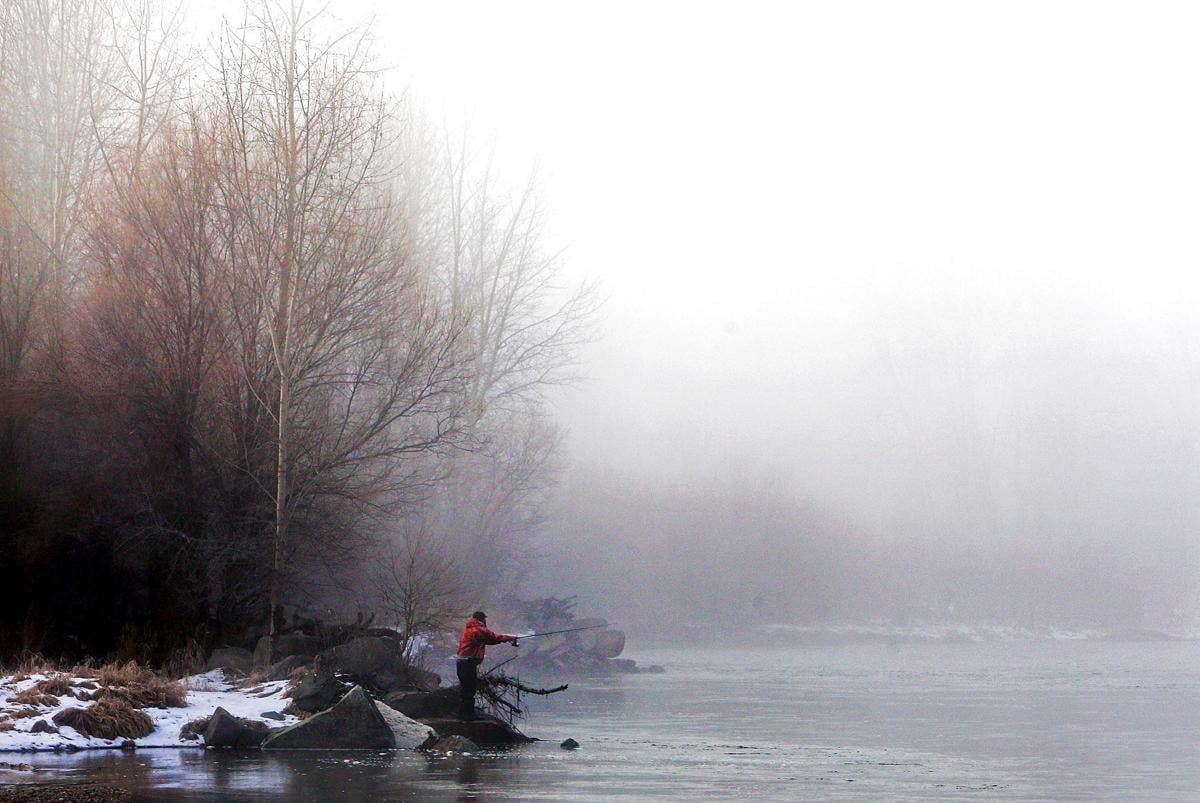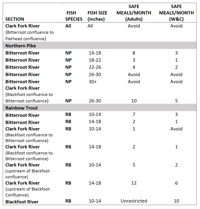
A fisherman doesn't let a little bit of fog and cold keep him from a morning on the Bitterroot River near Stevensville. But new state guidelines warn eating rainbow or Northern pike from the Clark Fork River between its confluences with the Bitterroot and Flathead rivers could be hazardous due to high levels of toxic chemicals in their flesh.
New state guidance recommends avoiding eating all species of fish on the Clark Fork River from the confluence with the Bitterroot up to the confluence with the Flathead River near Paradise due to the presence of “high levels of contaminants in the fish tissue.”
Test results from Montana Fish, Wildlife and Parks biologists renewed calls for further study and clean-up of industrial waste stored in the floodplain at the former pulp mill site in Frenchtown. The U.S. Environmental Protection Agency is conducting an environmental assessment that could eventually result in a Superfund designation, but the state guidelines note that no source of the toxins has been identified.
The geographic boundaries of the area covered by the consumption guidelines are limited to the area where samples were collected, spurring calls for further testing to determine whether the contaminants are present in fish farther upstream.
The tests were conducted only on Northern pike and rainbow trout.
Yet due to the resulting concentrations of dioxins, furans and PCBs, which can cause problems in the human nervous and immune systems or lead to birth defects, the consumption guidance was extended to all fish on that section of the Clark Fork. The guidance was issued by the State of Montana Fish Guidance Board, which includes the Montana Fish, Wildlife and Parks, the Department of Environmental Quality, and the Department of Public Health and Human Services.
The state also revised guidance for Northern pike and rainbow trout on the upstream section of the Clark Fork and on the Blackfoot and Bitterroot rivers.
The nonprofit Clark Fork Coalition, which has been advocating for clean-up at the site, believes the advisory is “even worse than we feared it might be,” said John DeArment, the group’s science director.
Walker Conyngham, president of Hellgate Hunters and Anglers, said the results are “a canary in the coal mine for that being an unhealthy ecosystem” to recreationists.
The guidelines didn’t shock many who’ve been watching the issue, since they heighten advice already in place.
In 2013-14, FWP water-pollution biologist Trevor Selch and fisheries biologist Dave Schmetterling pushed for limited testing of Northern pike and rainbow trout in the Frenchtown reach around the shuttered mill site. The results prompted a do-not-eat notice for Northern pike, a top-level predator, and a suggested “four meal per month” limit on rainbow trout from the Clark Fork’s confluence with the Bitterroot to the confluence with the Flathead River near Paradise.
The biologists pushed for more extensive sampling since then, and in 2018-19 more Clark Fork samples were collected in Clinton, East Missoula, Council Grove, the Frenchtown area, St. Regis as well as the Bitterroot and Blackfoot rivers. They concentrated on rainbows and pike, the latter of which is in an invasive species.
Because of the high levels of contaminants, out of caution, the agencies recommended that the order be expanded to all fish species from the Bitterroot confluence to the Flathead confluence, Selch said. Those include brown trout, whitefish, small- and large-mouth bass, northern pikeminnow, and sucker species. The geographical boundary in the study ends at Paradise because they “simply don’t have any more data downstream,” Selch said.
It’s “hard to know” when any more sampling will occur, he said, and the consumption advisories will likely stay intact “unless there’s an identified source that could be cleaned up, and then it would warrant additional sampling to see if that has an impact on the concentrations in the fish,” he said. In the interim, they’ve released that “conservative” consumption advice based on a lifetime of consumption for specific age groups.
The Bitterroot and Blackfoot had more limited testing. On the Bitterroot, there are guidelines for safe meals per month for Northern pike sized 14-26 inches, with warnings to avoid pike larger than 26 inches. For rainbow trout, there are limited meals per month.
On the Blackfoot, there are suggestions for limiting meals only for women and children to 10 fish a month.

The consumption guidelines issued on Friday by Montana Fish, Wildlife and Parks.
The limits are based on tests of raw fillets. The guidance notes that “using normal cooking practices, and keeping only smaller fish, can reduce exposure risk.”
The Clark Fork Coalition thought the extra caution was “unexpected,” said Karen Knudsen, executive director. They had anticipated, based on an earlier presentation in December, that it would be limited to pike and rainbow. They're "extremely pleased" to see that because of the concentrations are "unacceptably high, in those two species of fish, there’s a chance that they could be unacceptably high in other species of fish,’” she said.
They’re also continuing to push for more action at the mill site. DeArment, the coalition's science director, said, “people have a right to know the answer to that question: Where did this stuff come from, and do we need to be worried about continued discharges of it, and future accumulations of dioxin in these fish?”
The Frenchtown site was operated as a paper mill from the late 1950s through 2010, when Smurfit-Stone Container Corp. shuttered it. In 2011, a company called M2Green and Green Investment Group purchased the site and scrapped it for parts.
The site has since been subject of an EPA investigation into the extent of pollution and possible clean-up.
Part of Smurfit’s production process resulted in 1.6 million tons of bleached pulp, which has been stored in unlined holding ponds that rest in an irrigated floodplain of the Clark Fork, and come in contact with the river seasonally.
DeArment said the site needs a comprehensive EPA study, and the material in the holding ponds needs to be removed from the floodplain so “that trickle into the environment will stop.”
“So we’d really like answers to those questions,” DeArment said, “but at the moment it doesn’t look like we’re going to get a comprehensive investigation of them that will answer them in a reliable fashion … and in our view, that seems like an injustice on the part of the EPA and the [potentially responsible parties.]”
He pointed out that the highest concentrations of toxins in the fish study were found in the samples at St. Regis, the farthest test site en route to the next major tributary, the Flathead.
“Is that the end of it, or if we kept going downstream are we going to find even higher concentrations?" he asked "Or at some point, we would hope that they attenuate and go back to something like background."
At Paradise, the Flathead River flows down from the Flathead Indian Reservation and joins the Clark Fork.
The Confederated Salish and Kootenai Tribes said they are “actively consulting with the EPA to ensure that sources of dioxins, furans and PCBs detected in Northern pike and rainbow trout attributable to the Smurfit-Stone site are fully remediated,” said Mary Price, an environmental scientist with CSKT. “Tribal members will be made aware of Montana Fish Wildlife and Parks’ updated fish consumption advisory and will be advised to avoid consuming any fish taken from the Clark Fork River from the Bitterroot River to the Flathead River.”
Conyngham, with Hellgate Hunters and Anglers, said most people are already aware the fish in the area near the site are not safe to eat, but they were surprised to see how widespread the toxins were found in the study, and want to know how much farther upstream and downstream fish are affected.
Fishing guide Jason Brininstool, a regular in the affected area on the Clark Fork, also said he was “not surprised” by the new guidelines. In terms of business, he’s catch-and-release, so the consumption advisory itself doesn’t affect him immediately. The bigger worry is the long-term health of the area and whether any reclamation will happen before a potential breach of the lining ponds.
After the removal of Milltown Dam and other clean-up work in the Upper Clark Fork to Butte, this “seems like an unfortunate setback. We’re going in the wrong direction down there,” he said.
December 26, 2020 at 06:00AM
https://ift.tt/3nPzbhN
Catch but avoid eating: Toxic fish samples renew calls for Smurfit clean-up - The Missoulian
https://ift.tt/35JkYuc
Fish
No comments:
Post a Comment